In the rich tapestry of Norse mythology, Odin stands as a figure of immense complexity and profound influence. Revered as the Allfather, he is a deity of paradoxes, embodying wisdom, war, and magic. Odin’s multifaceted nature paints him not just as a war god, but also as a seeker of knowledge, a shapeshifter, and a guide to souls. This article delves into the intricate world of Odin, aiming to unravel the layers that constitute his character and his pivotal role in Norse cosmology. Through a comprehensive exploration, we will journey into the heart of Norse myths, examining Odin’s attributes, his relationships with other deities, and his impact on Viking society and beyond. Our goal is to present an accurate, insightful, and engaging portrayal of Odin, ensuring that the depth and breadth of his mythology are thoroughly explored and appreciated.
| Origin | Norse Mythology |
| Deity Type | Chief of the Aesir Gods |
| Appearance | Typically depicted as an elderly, bearded man with one eye, often accompanied by ravens |
| Role | Chief god of Norse mythology, associated with war, wisdom, poetry, and magic |
| Attributes | Known for his pursuit of knowledge and his sacrifice to gain wisdom |
| Companions | Often accompanied by two ravens, Huginn (Thought) and Muninn (Memory) |
| Mythological Role | Played a central role in many Norse myths and sagas |
| Cultural Impact | Remains a significant figure in Norse and Germanic folklore and mythology |
1. Historical Context and Sources of Odin’s Lore
Primary Sources of Norse Mythology
- The Poetic Edda: A collection of ancient Norse poems, the Poetic Edda is a crucial source for understanding Norse mythology, including Odin’s tales. These poems, passed down orally over centuries, were eventually compiled in the 13th century in Iceland.
- The Prose Edda: Written by Snorri Sturluson, an Icelandic historian, in the early 13th century, the Prose Edda offers a more systematic and detailed narration of Norse myths, including those of Odin. Sturluson’s work is invaluable for its explanations and interpretations of the older, often cryptic, poetic sources.
- Sagas and Historical Texts: Various sagas, like the Völsunga Saga, and historical texts like the Heimskringla, also contribute significantly to our knowledge of Odin. These texts blend myth with history, offering a unique perspective on Norse beliefs and culture.
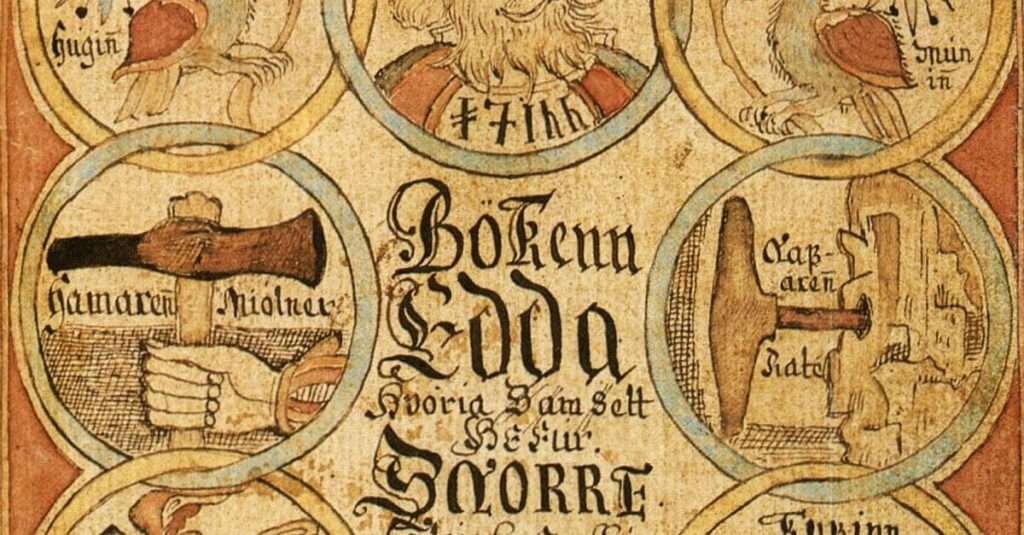
Historical Compilation of Norse Myths
- Oral Tradition to Written Word: The transition of Norse myths from oral folklore to written form during the Viking Age and thereafter played a crucial role in preserving these stories. This transition happened primarily in Iceland, a cultural hub for Norse literature.
- Contextual Influences: The historical context, including the Christianization of Scandinavia, influenced how these myths were recorded. The authors, often Christian monks or scholars, may have introduced their interpretations and biases into these pagan stories.
Archaeological Insights into Odin’s Myth
- Artifacts and Imagery: Archaeological findings, including statues, carvings, and amulets, provide visual representations of Odin, offering insights into how ancient Norse people visualized and revered him.
- Runestones and Burial Sites: Runestones and burial sites across Scandinavia and beyond have yielded inscriptions and artifacts that deepen our understanding of Odin’s worship and his role in Viking society.
- Interdisciplinary Approach: By combining literary and archaeological evidence, a more holistic picture of Odin’s place in Norse mythology emerges, highlighting his enduring influence and the rich cultural heritage of the Norse people.

2. The Many Facets of Odin
Unraveling Odin’s Attributes and Powers
- Master of Wisdom and Magic: Odin is renowned for his unquenchable thirst for knowledge, epitomized by his sacrifice of an eye at the well of Mimir to gain cosmic wisdom. This act underscores his role as a god who values knowledge above all else, even at great personal cost.
- Warrior and Tactician: As a god of war, Odin is depicted not just as a fierce warrior but also as a master tactician and strategist, influencing battles with his cunning and foresight.
- The Enchanter: Odin’s mastery of magic, particularly the ancient art of seidr, sets him apart. He is a shape-shifter, capable of altering his form and traversing the realms of existence.
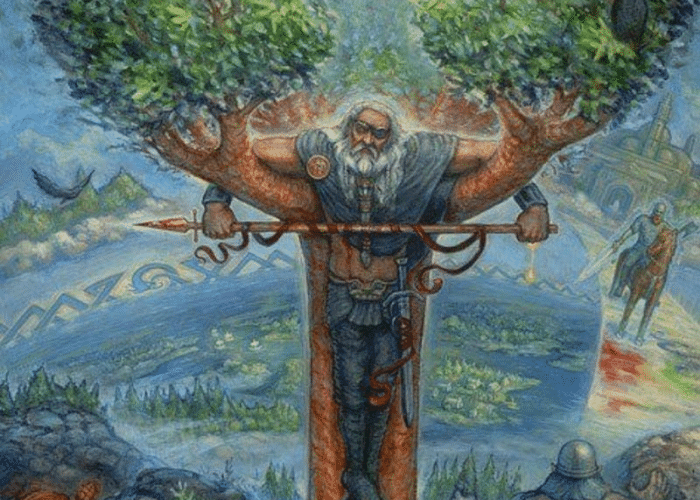
Odin’s Multidimensional Roles
- Sovereign of Poetry: Odin’s association with poetry is tied to his quest for the mead of poetry, a magical brew that bestows the gift of eloquence and creative inspiration, reflecting his influence over the realm of arts and letters.
- Guide of Souls: As the god of the dead, Odin presides over Valhalla, the hall where slain warriors are gathered, reflecting his role in the afterlife and the veneration of ancestors in Norse culture.
The Quest for Knowledge: Sacrifice and Insight
- Sacrifice for Wisdom: The most iconic tale of Odin’s quest for knowledge is his self-imposed ordeal on Yggdrasil, the world tree, where he hung for nine nights, pierced by his own spear, to grasp the secrets of the runes. This act symbolizes his willingness to endure pain and sacrifice for greater understanding.
- The Wells of Knowledge: Odin’s interactions with the wells of knowledge, including the well of Mimir, further emphasize his relentless pursuit of wisdom. These narratives highlight the Norse belief in wisdom’s value and the sacrifices required to attain it.
3. Odin’s Kin and Kinships
The Allfather’s Family Circle
- Frigg, the Beloved Consort: Frigg, Odin’s wife, is a central figure in Norse mythology, often associated with foresight and wisdom. Her relationship with Odin is one of mutual respect and power, with both deities possessing unique attributes and spheres of influence.
- Thor and Baldr, Sons of Odin: Thor, the god of thunder, is perhaps the most renowned of Odin’s sons, known for his strength and battle prowess. Baldr, on the other hand, represents purity and beauty. The stark differences between Thor and Baldr exemplify Odin’s diverse lineage and the varied aspects of Norse divinity.
- Other Notable Relations: Loki, the trickster god, often regarded as Odin’s blood brother, extends Odin’s family to include other significant figures.This complex relationship adds a layer of intrigue and conflict within the Norse pantheon.
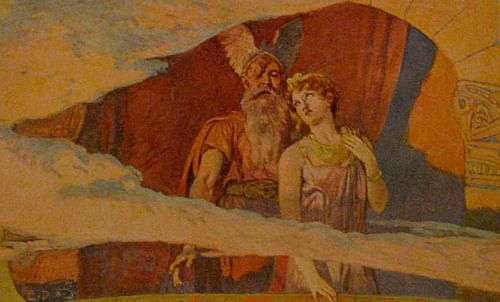
Relationships with the Norse Pantheon
- The Aesir-Vanir War: Odin played a pivotal role in the Aesir-Vanir war, a foundational conflict in Norse mythology between two groups of gods. His actions and strategies during the war demonstrate his leadership and diplomatic skills, as the war concludes with an exchange of hostages, leading to a truce and the eventual integration of the two divine families.
- Alliances and Rivalries: Odin’s interactions with other gods, like Freyja, the Vanir goddess of love and war, and his aforementioned ties with Loki, showcase a network of alliances and rivalries. These relationships shape the intricate web of stories and conflicts in Norse mythology.
Shaping the Mythological Narrative
- Impact on Norse Lore: Odin’s familial and divine relationships significantly impact the narrative of Norse mythology. The dynamics between Odin and his kin are not just tales of gods and goddesses but also reflections of human emotions and societal values.
- Symbolism and Moral Lessons: These stories, laden with symbolism, provide insights into Norse culture’s moral and ethical frameworks. The tales of Odin and his family often carry deeper meanings about loyalty, power, wisdom, and the inevitability of fate.
4. Odin in Mythic Narratives
The Discovery of the Runes
- Narrative: In a profound display of self-sacrifice, Odin hangs himself from Yggdrasil, the cosmic tree, and pierces himself with his spear for nine nights. In this state of near-death, he discovers the runes, symbols of immense magical and practical power.
- Symbolism and Cultural Insight: This myth exemplifies the Norse value of self-sacrifice for greater wisdom. The runes, beyond their magical connotations, were integral to Norse culture in communication and divination, symbolizing the deep connection between wisdom, sacrifice, and power.
The Quest for the Mead of Poetry
- Narrative: Odin’s quest for the mead of poetry, a substance that bestows poetic talent and wisdom upon those who drink it, showcases his cunning. Disguising himself and employing trickery, he obtains the mead from the giant Suttungr, ensuring its benefit for gods and humans alike.
- Symbolism and Cultural Insight: This tale reflects the Norse admiration for wit and intelligence. The mead, symbolizing poetic and intellectual inspiration, underscores the importance placed on eloquence and creative expression in Norse society.
Odin’s Role in Ragnarok
- Narrative: In Ragnarok, the prophesied end of the world, Odin faces his ultimate fate. He is foretold to be devoured by the wolf Fenrir, a moment emblematic of the cyclical nature of Norse cosmology.
- Symbolism and Cultural Insight: Odin’s foreknown demise at Ragnarok speaks to the Norse concept of destiny and the inevitable cycle of creation and destruction. This acceptance of fate, even by the gods, highlights a key aspect of Norse belief – the idea that courage and honor lie in facing one’s destiny head-on.

5. The Shadow of Odin in Viking Life
Odin’s Influence on Viking Warfare and Society
- Warrior Ethos: Odin’s status as a god of war profoundly influenced the Viking warrior ethos. His association with valor, strategy, and the warrior’s afterlife in Valhalla provided a spiritual framework that valorized bravery and prowess in battle.
- Societal Values: Beyond warfare, Odin’s wisdom and pursuit of knowledge impacted the broader societal values. His traits of intelligence, foresight, and leadership were ideals admired and aspired to in Viking society. This reverence for Odin helped shape a culture that valued not just physical strength but also wisdom and cunning.
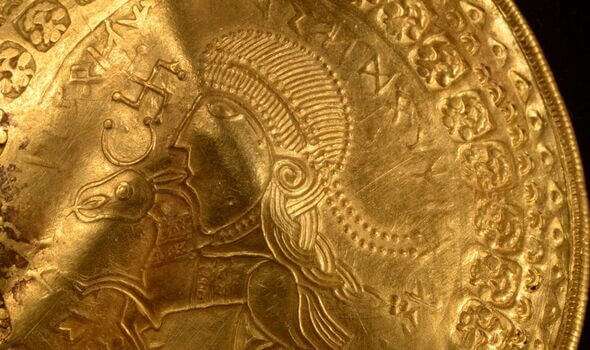
Spiritual Practices and Rituals
- Priestly Class and Sacrificial Rites: Odin was central to the spiritual practices of the Norse people. Priests and shamans, often associated with Odin due to his mastery of magic and prophecy, conducted rituals and sacrifices in his honor, seeking his guidance and favor.
- The Cult of Odin: Certain archaeological evidence suggests the existence of a specific cult dedicated to Odin, characterized by particular rituals and sacrifices, including the well-documented practice of human and animal sacrifice to appease the gods and ensure their favor.
Artistic Depictions and Symbolism
- Imagery in Artifacts: Frequently, Viking artists depict Odin in various forms of art, including statuettes, carvings, and jewelry. They often portray him with his characteristic attributes, such as his spear, Gungnir, and his two ravens, Huginn and Muninn, which symbolize thought and memory.
- Runestones and Iconography: Runestones across Scandinavia depict scenes from Norse mythology, including those of Odin. These carvings not only served as memorial stones but also as a testament to the pervasive influence of Odin and Norse mythology in Viking art and iconography.
6. Odin’s Enduring Legacy in the Modern World
The Allfather in Contemporary Media and Literature
- Odin in Popular Literature: Modern literature has embraced Odin, often portraying him as a central figure in retellings and adaptations of Norse myths. Authors have explored his character in various genres, from fantasy to historical fiction, highlighting his complexity and enduring appeal.
- Depiction in Film and Television: In the realm of film and television, Odin frequently appears as a character in works inspired by Norse mythology. These portrayals often emphasize his wisdom, power, and sometimes, his moral ambiguity, reflecting the multifaceted nature of his character as seen in ancient myths.
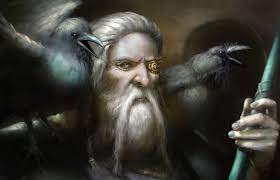
Influence in Popular Culture
- Comic Books and Graphic Novels: Odin has been a prominent figure in comic books, particularly in series that incorporate mythological themes. These adaptations often take creative liberties but retain the core aspects of his mythology, introducing him to a broader, younger audience.
- Video Games and Virtual Realities: In video games, Odin often appears as a character or influence, with game narratives drawing on his mythology. This medium allows for interactive engagement with his character and the Norse mythological world.
Resurgence of Interest in Norse Mythology
- Cultural Revival: There has been a notable resurgence of interest in Norse mythology, with Odin at the forefront. This revival is seen in academic studies, neo-pagan movements, and cultural festivals, highlighting a renewed fascination with Norse heritage and its mythological traditions.
- Educational and Cultural Exploration: Odin’s myths are increasingly being explored in educational contexts, providing insights into ancient Norse culture, belief systems, and literary traditions. This resurgence of interest reflects a broader cultural trend of exploring and valuing ancient mythologies for their historical and literary significance.
7. Conclusion
Odin, with his multifaceted persona and profound impact, emerges as a figure of immense complexity and enduring appeal in Norse mythology. His character, embodying wisdom, war, and magic, transcends mere mythological confines, reflecting the values and beliefs of the ancient Norse. Odin’s influence, from guiding Viking warriors and seers to inspiring modern literature and media, highlights his role as a symbol of wisdom, power, and the inexorable march of fate. His enduring legacy in Norse mythology and beyond is a testament to the timeless allure of mythological narratives in understanding our cultural heritage and exploring the depths of human imagination and spirituality. Odin, as the Allfather, continues to captivate and inspire, remaining a potent symbol of the rich tapestry of Norse mythology and its lasting impact on the world.
